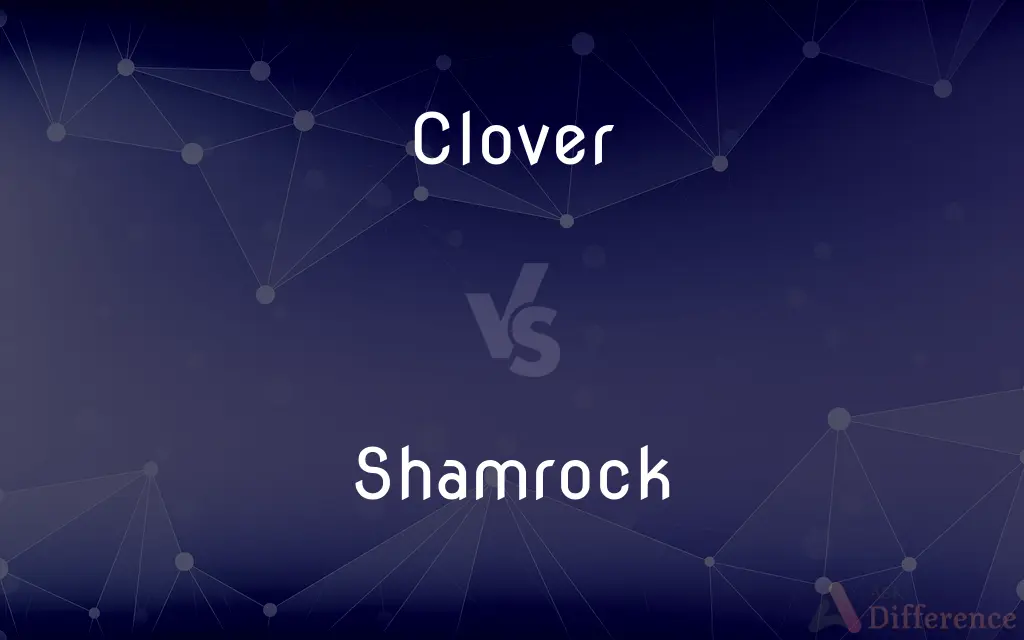Clover vs. Shamrock — What's the Difference?
By Tayyaba Rehman & Fiza Rafique — Updated on March 9, 2024
Clover refers to plants in the genus Trifolium, known for their three-part leaves, while Shamrock is a symbol of Ireland, often represented by a three-leafed clover.

Difference Between Clover and Shamrock
Table of Contents
ADVERTISEMENT
Key Differences
Clovers are a broad category within the genus Trifolium, which includes several hundred species with a characteristic three-part leaf structure. These plants are widespread and known for their agricultural benefits, such as fixing nitrogen in the soil. Shamrocks, on the other hand, are specifically associated with Irish culture and folklore and are not a distinct botanical species. The term "shamrock" is derived from the Irish word "seamróg," meaning "little clover," and typically refers to a few species of clover, especially those with three leaves, which are considered symbolic.
While all shamrocks are technically clovers, not all clovers are considered shamrocks. Shamrocks hold significant cultural importance in Ireland, being an emblem of luck and the symbol of St. Patrick's Day. In contrast, clovers are generally valued for their agricultural uses and aesthetic appeal in various global contexts, without the specific cultural connotations tied to the shamrock.
Botanically, clovers include species with various leaf counts, but the term "shamrock" traditionally refers to those with three leaves. While finding a four-leaf clover is often considered lucky due to its rarity, the traditional shamrock symbol always has three leaves, each said to represent a theme in Irish lore, such as faith, hope, and love.
In terms of usage, clover plants are cultivated and used in a variety of ways, including as fodder for livestock, cover crops in agriculture, and ornamental plants in gardens. Shamrocks, while also physically grown, are more widely recognized in symbolic forms, such as in logos, designs, and during St. Patrick's Day celebrations.
Culturally, the shamrock is deeply embedded in Irish history and folklore, serving as a national symbol and an emblem of good luck. Clover plants, without the specific "shamrock" designation, lack this cultural significance and are appreciated more for their practical benefits and natural beauty.
ADVERTISEMENT
Comparison Chart
Definition
A genus of plants with three-part leaves
A symbol of Ireland, often a three-leafed clover
Species
Several hundred within the genus Trifolium
Specifically refers to a few clover species
Cultural Significance
Agricultural and aesthetic value
Emblem of luck and Irish identity
Leaf Count
Mostly three, but can vary
Traditionally three
Usage
Agriculture, fodder, ornamentals
Symbolic, especially in Irish culture
Compare with Definitions
Clover
A plant genus known for nitrogen-fixing and three-part leaves.
The farmer planted clover to enrich the soil.
Shamrock
An Irish symbol, often a three-leafed clover.
He wore a shamrock on St. Patrick's Day.
Clover
Commonly found in meadows and used as fodder.
The field was covered in lush clover.
Shamrock
Used in logos and symbols related to Ireland.
The airline's logo features a shamrock.
Clover
Associated with luck when four-leafed.
She found a rare four-leaf clover.
Shamrock
Represents themes like faith, hope, and love.
The shamrock stands for important values in Irish culture.
Clover
Used in green manure and cover cropping.
Clover is planted as a cover crop to improve soil health.
Shamrock
A tradition in celebrating St. Patrick's Day.
Shamrocks decorate the parade for St. Patrick's Day.
Clover
Can have white, red, or purple flowers.
The white clover blossoms attract bees.
Shamrock
A token of good luck and Irish heritage.
She keeps a shamrock charm for luck.
Clover
Clover or trefoil are common names for plants of the genus Trifolium (Latin, tres "three" + folium "leaf"), consisting of about 300 species of flowering plants in the legume or pea family Fabaceae originating in Europe. The genus has a cosmopolitan distribution with highest diversity in the temperate Northern Hemisphere, but many species also occur in South America and Africa, including at high altitudes on mountains in the tropics.
Shamrock
A shamrock is a young sprig, used as a symbol of Ireland. Saint Patrick, Ireland's patron saint, is said to have used it as a metaphor for the Christian Holy Trinity.
Clover
Any of various herbs of the genus Trifolium in the pea family, having trifoliolate leaves and dense heads of small flowers and including species grown for forage, for erosion control, and as a source of nectar for honeybees.
Shamrock
A plant having compound leaves with three small leaflets, especially a clover or wood sorrel.
Clover
Any of several other plants in the pea family, such as bush clover and sweet clover.
Shamrock
The compound leaf of one of these plants.
Clover
Any of several nonleguminous plants, such as water clover.
Shamrock
A representation of one of these plants or leaves, used as a national emblem of Ireland.
Clover
A plant of the genus Trifolium with leaves usually divided into three (rarely four) leaflets and with white or red flowers.
Shamrock
The trefoil leaf of any small clover, especially Trifolium repens, or such a leaf from a clover-like plant, commonly used as a symbol of Ireland.
She wore a shamrock in honor of her Irish ancestry.
Clover
(cartomancy) The second Lenormand card, representing hope, optimism and short-term luck.
Shamrock
Any of several species of small clover-like plant species, with trefoil leaves, especially Trifolium repens.
The fields were covered with shamrocks.
Clover
A plant of different species of the genus Trifolium; as the common red clover, Trifolium pratense, the white, Trifolium repens, and the hare's foot, Trifolium arvense.
Shamrock
A trifoliate plant used as a national emblem by the Irish. The legend is that St. Patrick once plucked a leaf of it for use in illustrating the doctrine of the trinity.
Clover
A plant of the genus Trifolium
Shamrock
Creeping European clover having white to pink flowers and bright green leaves; naturalized in United States; widely grown for forage
Shamrock
Eurasian plant with heart-shaped trifoliate leaves and white pink- or purple-veined flowers
Shamrock
Clover native to Ireland with yellowish flowers; often considered the true or original shamrock
Common Curiosities
Is a four-leaf clover a shamrock?
No, traditional shamrocks have three leaves; four-leaf clovers are considered lucky but are not shamrocks.
Do clovers have any benefits besides being fodder?
Yes, clovers improve soil health by fixing nitrogen and are also valued as ornamental plants.
Can clovers be harmful?
While generally beneficial, clovers can be considered weeds in certain contexts and some species may be toxic to livestock in large quantities.
Are shamrocks only relevant on St. Patrick's Day?
While their prominence peaks on St. Patrick's Day, shamrocks are a year-round symbol of Irish heritage and identity.
Do shamrocks grow only in Ireland?
No, the plants commonly referred to as shamrocks can grow in many temperate regions around the world.
Can any clover be considered a shamrock?
Not all clovers are considered shamrocks; typically, only certain species like the three-leafed ones are associated with the shamrock symbol.
Why is the shamrock a symbol of Ireland?
The shamrock became associated with St. Patrick, Ireland's patron saint, who is said to have used it as a metaphor for the Christian Holy Trinity.
Is finding a four-leaf clover related to Irish culture?
While not specifically Irish, the rarity of four-leaf clovers has made finding one considered lucky in many cultures, including Ireland.
Why might someone choose a clover or shamrock tattoo?
A clover tattoo might symbolize luck or nature, while a shamrock tattoo often represents Irish heritage or pride.
How can I identify a true shamrock plant?
True shamrocks are typically three-leafed clovers, often of the species Trifolium repens or Trifolium dubium.
How are clovers used in agriculture?
Clovers are used as cover crops to fix nitrogen in the soil, reducing the need for chemical fertilizers.
Are there any rituals or traditions involving shamrocks?
On St. Patrick's Day, it's customary to wear shamrocks or green clothing, and the "drowning of the shamrock" is a traditional toast.
How do clovers contribute to biodiversity?
Clovers provide nectar for pollinators and improve soil health, supporting a diverse ecosystem.
What's the difference between shamrock and four-leaf clover merchandise?
Shamrock merchandise celebrates Irish culture and St. Patrick's Day, while four-leaf clover items are generally associated with good luck.
Can clovers be used in medicine?
Some clover species have been used in traditional medicine, though their efficacy and safety can vary.
Share Your Discovery

Previous Comparison
Frighten vs. Frightened
Next Comparison
Description vs. NarrationAuthor Spotlight
Written by
Tayyaba RehmanTayyaba Rehman is a distinguished writer, currently serving as a primary contributor to askdifference.com. As a researcher in semantics and etymology, Tayyaba's passion for the complexity of languages and their distinctions has found a perfect home on the platform. Tayyaba delves into the intricacies of language, distinguishing between commonly confused words and phrases, thereby providing clarity for readers worldwide.
Co-written by
Fiza RafiqueFiza Rafique is a skilled content writer at AskDifference.com, where she meticulously refines and enhances written pieces. Drawing from her vast editorial expertise, Fiza ensures clarity, accuracy, and precision in every article. Passionate about language, she continually seeks to elevate the quality of content for readers worldwide.















































